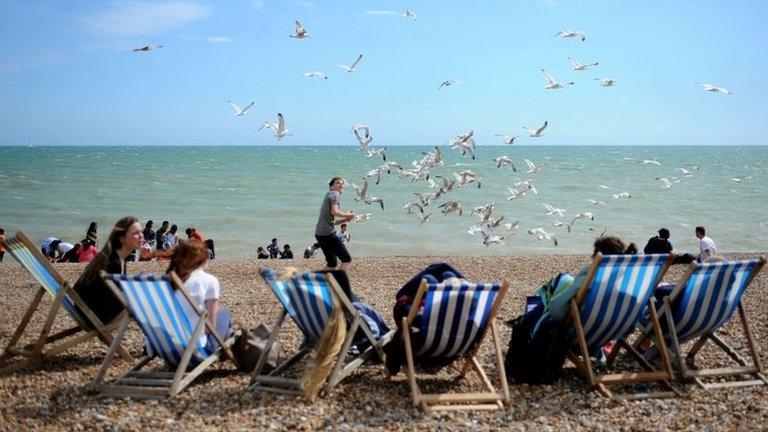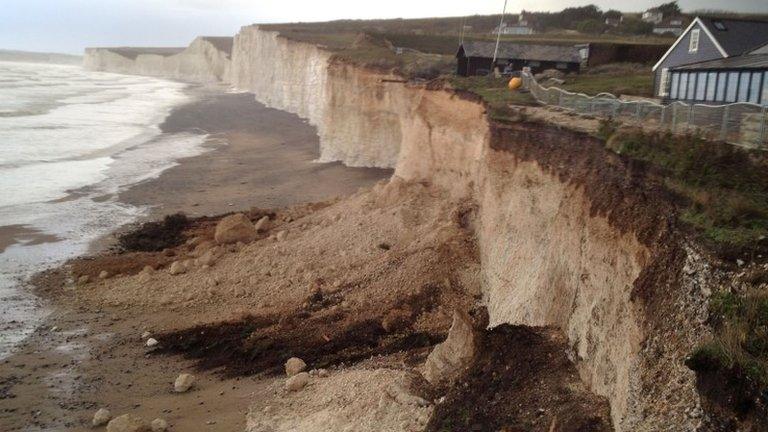Urgent coastal protection needed, says National Trust
- Published

The National Trust bought a stretch of Dunwich Heath on the Suffolk coast and plans to restore heathland habitat
As parts of the UK face the first of the wet winter weather, the National Trust wants action to manage threats to our storm-battered coastline.
In England, just one in three coastal local authorities has long-term, informed plans in place, it claims.
The Trust cites examples of adaptive "soft engineering" and innovation, such as creating flood banks and reed beds.
It even encourages the design and use of moveable buildings close to particularly vulnerable, quickly-eroding areas of the coast.
The main thrust of its report is a call to adapt to the diverse challenges at different coastal locations.
Storm Abigail: Scotland prepares for high winds and rain
Approaches like this should happen instead of continuing a tradition of building sea defences, which have perpetuated "a cycle of construct, fail and reconstruct", the Shifting Shores report says.
The National Trust is responsible for 700 miles of British coast and said: "As a nation we can no longer rely solely on building our way out of trouble."
Exposed to the sea

Formby is predicted to lose at least 400m of beach to the sea in the next century
The Environment Agency has previously estimated that 700 properties in England alone could be lost to coastal erosion by around 2030.
But building in at-risk areas has continued. In England in 2005 the number of buildings at medium to high risk from coastal change was 117,000 - by 2014 this had grown to 129,000.
Phil Dyke, coastal marine adviser at the National Trust, told BBC News that a lack of funding for local authorities had contributed to a situation whereby "there is no clear mechanism to help people whose properties are at risk".
"We should be thinking about adaptive responses," Mr Dyke told BBC News.

Reconstructing the coast
In Pembrokeshire, the National Trust is gradually restoring and extending reed beds, fen meadows and dune grasslands to protect the coastline
The Environment Agency built 7km of floodbank near Selsey, West Sussex, and then breached the shingle beach - creating 183 hectares of saltmarsh and mudflat habitat and replacing those being lost elsewhere through coastal squeeze
On a much smaller scale, innovative chalet buildings, developed by Bourne Leisure at Corton in Suffolk, are moveable and can be placed out of harm's way as the sea encroaches

Andy Smith, chairman of the Local Government Association's coastal special interest group, said he welcomed the report, but he added that it was important "to look at the wider picture".
"Defence of the coast and adaptation to coastal change are equal partners and have to be looked at in every place subject to the place in question," he told BBC News.
Both the departments for environment and for local government have agreed spending cuts, but the National Trust urged the Department for Environment, Food & Rural Affairs (Defra) to put funding in place.

A Defra spokesman said that over the next six years the government planned to invest £1bn "to manage coastal flooding and erosion, so we can better protect 15,000 homes".
But the LGA's Mr Smith pointed out that funding from government was "very focused on protecting property and building defences".
He said that to move "away from having a coast defence perspective", local authorities needed a wider remit to apply to this central fund for their long-term plans.
"We welcome a greater focus on this issue," he told BBC News.
"But local authorities are very strapped for cash and we need the resources to do this topic justice."
Mr Dyke added: "Action is now needed by all coastal stakeholders to manage the threats to our beautiful and diverse coast to prevent us drifting into a future where our coast is a rim of concrete."
- Published22 June 2015

- Published21 February 2014
